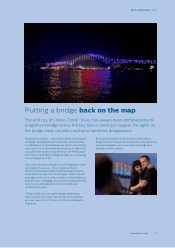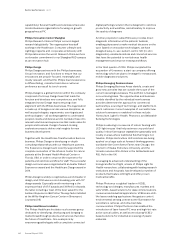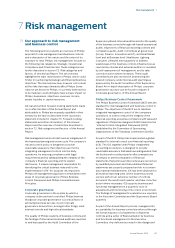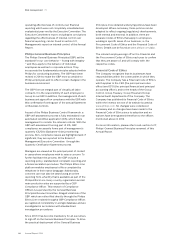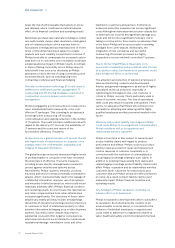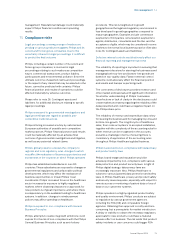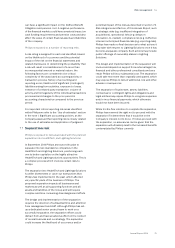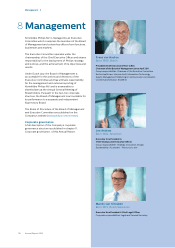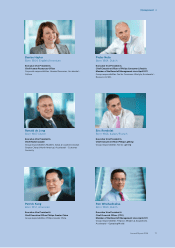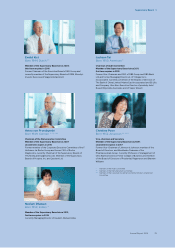Philips 2014 Annual Report Download - page 71
Download and view the complete annual report
Please find page 71 of the 2014 Philips annual report below. You can navigate through the pages in the report by either clicking on the pages listed below, or by using the keyword search tool below to find specific information within the annual report.Risk management 7.3
Annual Report 2014 71
Philips’ inability to secure and retain intellectual
property rights for products, whilst maintaining overall
competitiveness, could have a material adverse eect
on its results.
Philips is dependent on its ability to obtain and retain
licenses and other intellectual property (IP) rights
covering its products and its design and manufacturing
processes. The IP portfolio is the result of an extensive
patenting process that could be inuenced by a number
of factors, including innovation. The value of the IP
portfolio is dependent on the successful promotion and
market acceptance of standards developed or co-
developed by Philips. This is particularly applicable to
Consumer Lifestyle where third-party licenses are
important and a loss or impairment could have a
material adverse impact on Philips’ nancial condition
and operating results.
7.4 Operational risks
Transformation programs
In 2011 Philips started a very extensive transformation
program (Accelerate!) to unlock Philips’ full potential.
Accelerate! spans a time period of several years. In 2014
as a next phase in the Accelerate! transformation
program Philips announced that it would separate its
businesses into two new t for purpose companies,
HealthTech and Lighting Solutions. Failure to achieve
the objectives of the transformation programs may
have a material adverse eect on the mid and long term
nancial targets.
In addition the transformation program of the Finance
function may expose Philips to adverse changes in the
quality of its systems of internal control.
Failure to achieve improvements in Philips’ solution and
product creation process and/or increased speed in
innovation-to-market could hamper Philips’ protable
growth ambitions.
Further improvements in Philips’ solution and product
creation process, ensuring timely delivery of new
solutions and products at lower cost and upgrading of
customer service levels to create sustainable
competitive advantage, are important in realizing
Philips’ protable growth ambitions. The emergence of
new low-cost competitors, particularly in Asia, further
underlines the importance of improvements in the
product creation process. The success of new solution
and product creation, however, depends on a number
of factors, including timely and successful completion
of development eorts, market acceptance, Philips’
ability to manage the risks associated with new
products and production ramp-up issues, the ability of
Philips to attract and retain employees with the
appropriate skills, the availability of products in the
right quantities and at appropriate costs to meet
anticipated demand and the risk that new products and
services may have quality or other defects in the early
stages of introduction. Accordingly, Philips cannot
determine in advance the ultimate eect that new
solutions and product creations will have on its nancial
condition and operating results. If Philips fails to
accelerate its innovation-to-market processes and fails
to ensure that end-user insights are fully captured and
translated into solution and product creations that
improve product mix and consequently contribution, it
may face an erosion of its market share and
competitiveness, which could have a material adverse
eect on its nancial condition and operating results.
Risk of unauthorized use of intellectual property rights
Philips produces and sells products and services which
incorporates technology protected by intellectual
property rights. Philips develops and acquires
intellectual property rights on regular basis. Philips is
exposed to the risk that intellectual property rights on
technology applied in its products and services is
claimed to be owned by third parties, who, in case their
claims of infringement of such intellectual property
rights are awarded, would be entitled to damages and
nes.
If Philips is unable to ensure eective supply chain
management, e.g. facing an interruption of its supply
chain, including the inability of third parties to deliver
parts, components and services on time, and if it is
subject to rising raw material prices, it may be unable to
sustain its competitiveness in its markets.
If Philips is unable to ensure eective supply chain
management, e.g. facing an interruption of its supply
chain, including the inability of third parties to deliver
parts, components and services on time, Philips may be
unable to sustain its competitiveness in its markets.
Philips is continuing the process of creating a leaner
supply base with fewer suppliers, while maintaining
dual / multiple sourcing strategies where possible. This
strategy very much requires close cooperation with
suppliers to enhance, among other things, time to
market and quality. In addition, Philips is continuing its
initiatives to reduce assets through outsourcing. These
processes may result in increased dependency on
external suppliers and providers. Although Philips
works closely with its suppliers to avoid supply-related
problems, there can be no assurance that it will not
encounter supply problems in the future or that it will
be able to timely replace a supplier that is not able to
meet its demand.
Shortages or delays could materially harm its business.
Most of Philips’ activities are conducted outside of the
Netherlands, and international operations bring
challenges. For example, production and procurement
of products and parts in Asian countries are increasing,
and this creates a risk that production and shipping of
products and parts could be interrupted by regional
conicts or a natural disaster, such as occurred in Japan
in 2011. A general shortage of materials, components or
subcomponents as a result of natural disasters also


